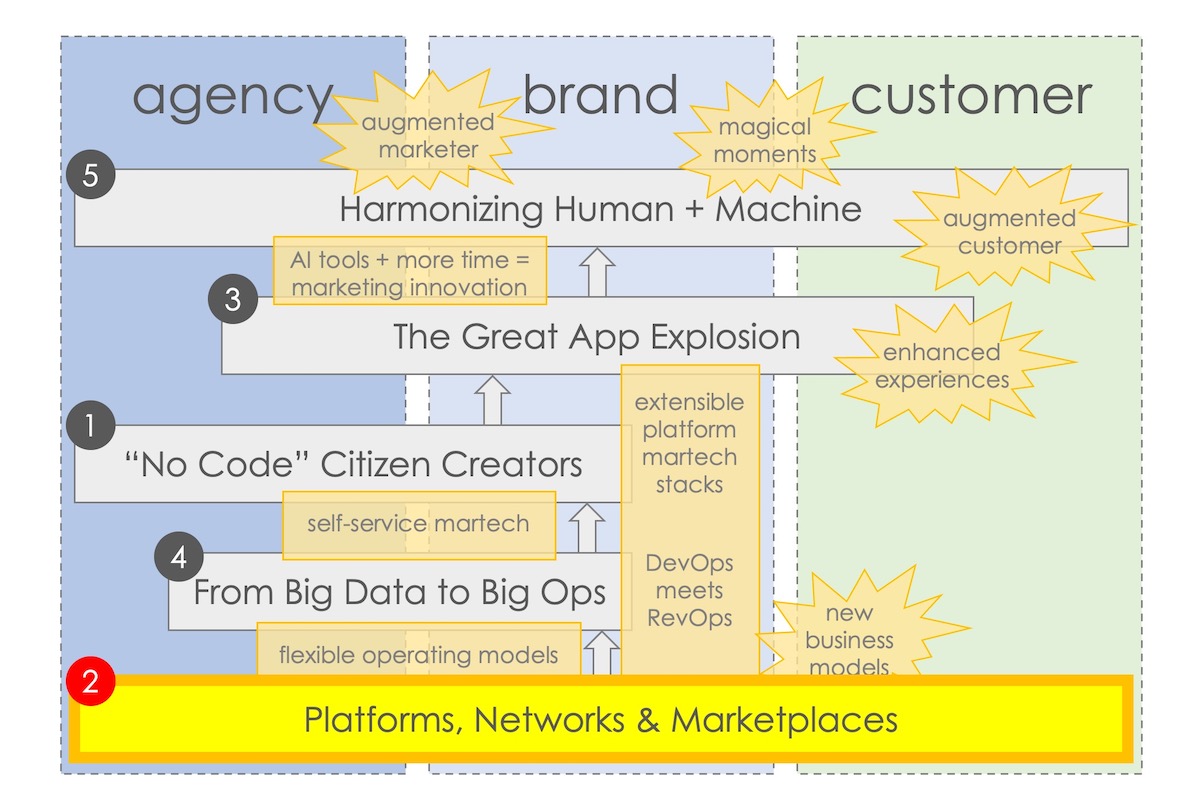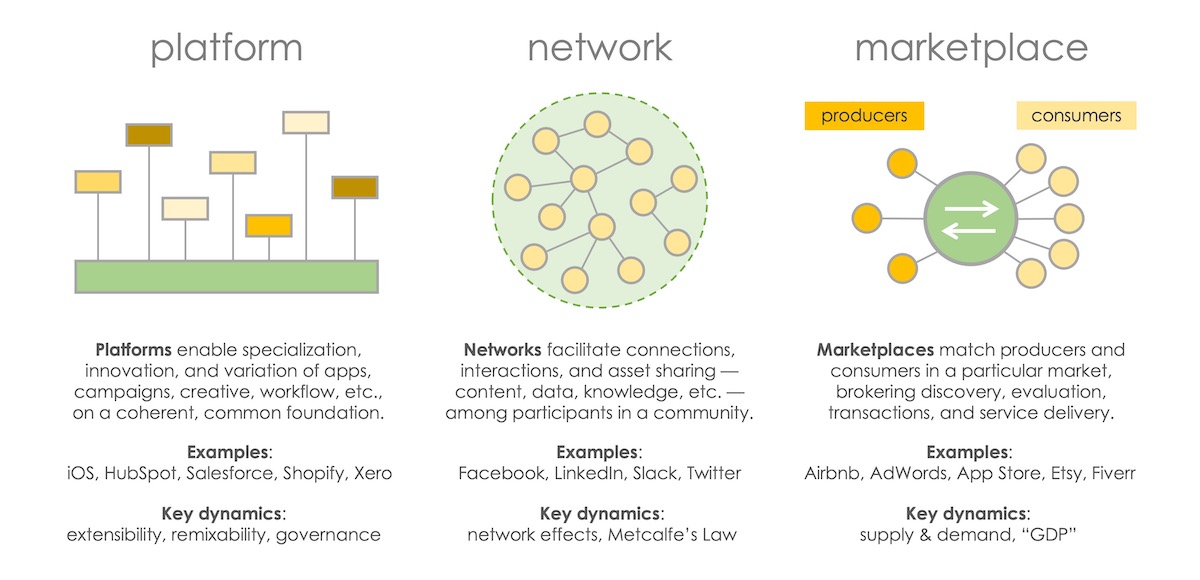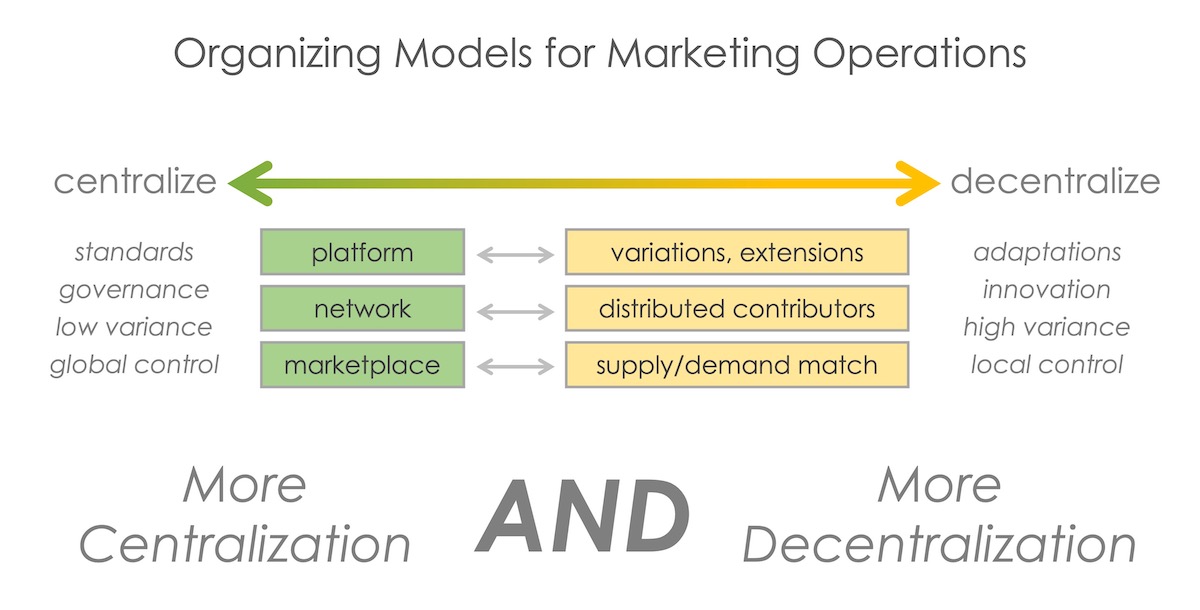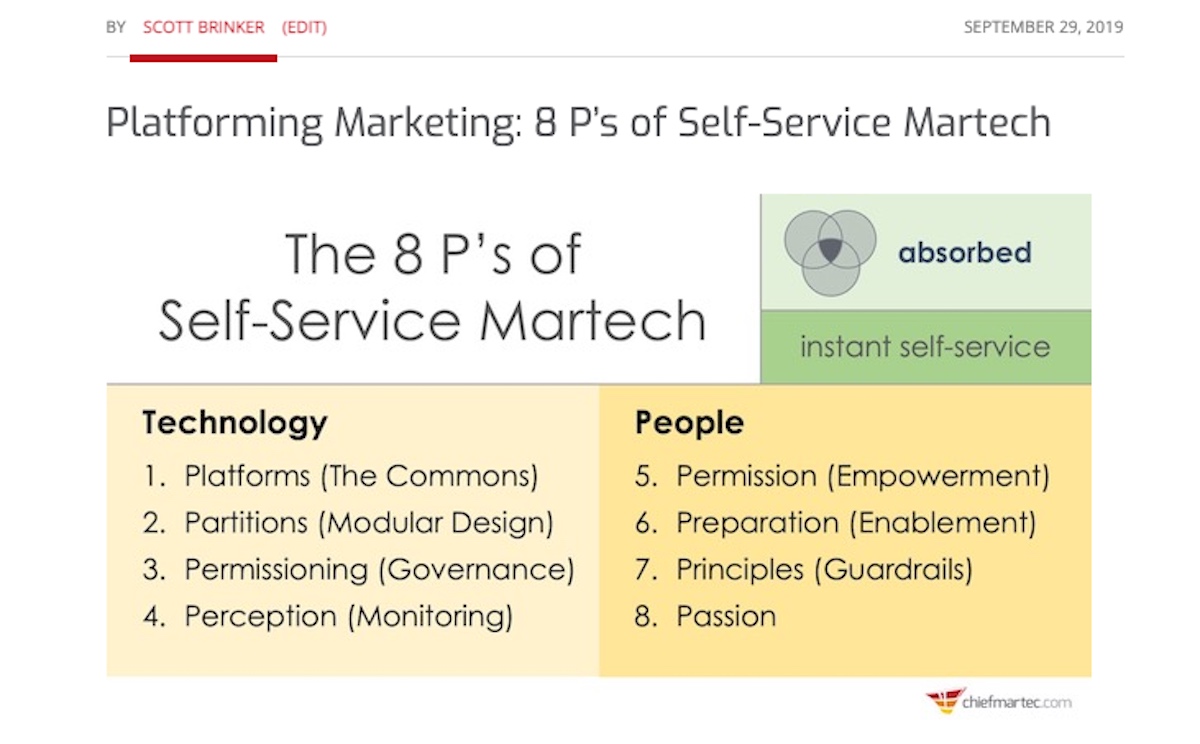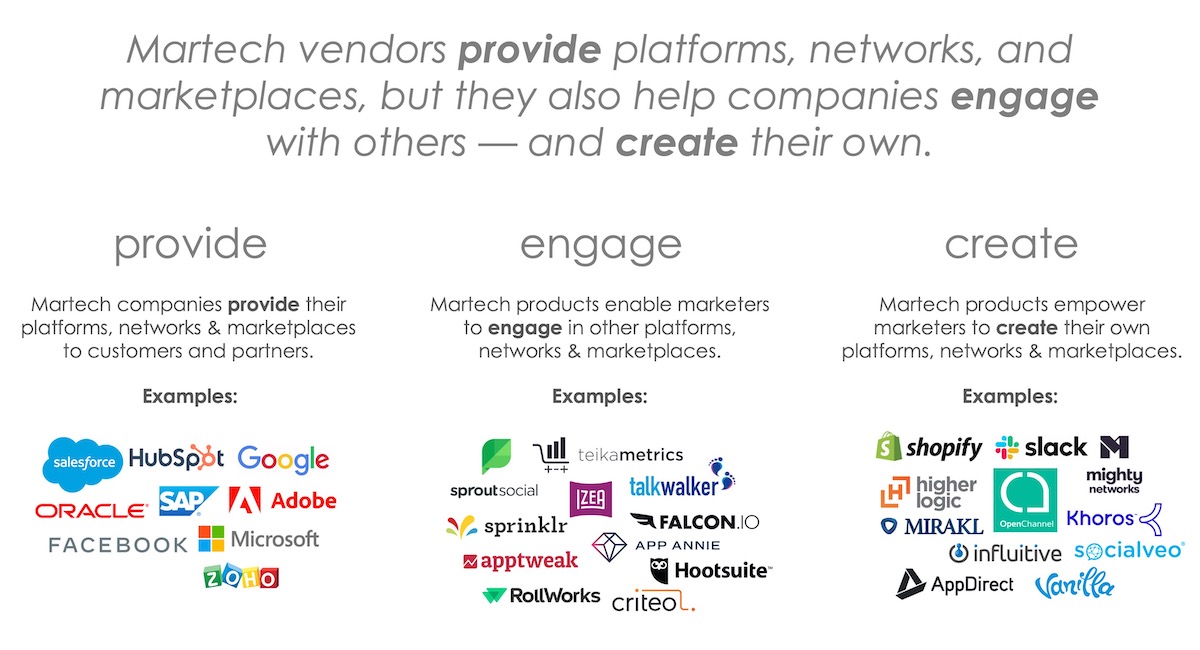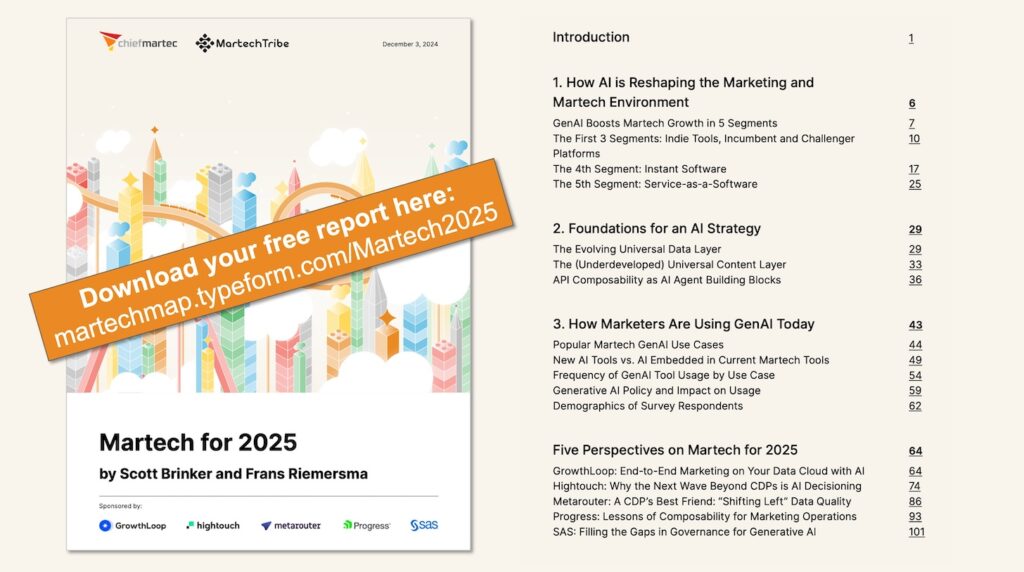Earlier this year, I collaborated with Jason Baldwin, global head of product management at WPP, on this project to describe five major trends in martech that would shape the decade ahead for agencies and brands. You can download our full paper, including many terrific interviews from WPP executives. I’m republishing it here as a 7-part series. This is part 3.
Our previous era of business thrived through chains. Value chains. Supply chains. Distribution chains. Linear flows that produced and delivered goods and services. Internal workflows often mirrored this assembly line mental model, managing knowledge work the same way as physical manufacturing. Project management Gantt charts epitomized this view.
The advantage of such chains was optimizing for efficiency, squeezing out waste from even highly elaborate end-to-end processes. As long as we were operating in a stable environment, we could produce relatively predictable outcomes with speed, scale, and precision.
But the digital world is eclipsing traditional chain-style thinking. There’s much less predictability in today’s business environment. Markets, competitors, and customer expectations can change swiftly. Every year, new technologies bring new capabilities, new channels, and new consumer experiences — in turn enabling new business models and operating models that harness them. The speed by which these changes are spread and adopted continues to accelerate.
In this environment, efficiency is still valued. But we’ve come to appreciate agility, adaptability, and resilience as even more valuable business characteristics. What good is a highly efficient operational pipeline, if it’s eclipsed by an entirely different kind of competition or some other sudden change in circumstances?
Yet while a highly connected, digital world has generated these new challenges for us, it has also given us new organizational structures to overcome them. Three patterns have emerged:
PATTERN #1: PLATFORMS
Software and hardware platforms have ushered in tremendous extensibility and remixability on top of standardized foundations — from early operating systems, such as Windows, to modern device platforms, such as iOS, Android, Amazon Alexa, and Philips Hue, to current SaaS platforms such as HubSpot, Salesforce, Shopify, and Xero.
Developers stand on the shoulders of giants to create specialized apps that inherit the capabilities of the platform upon which they’re built. Users of these platforms benefit from a spectacular variety of apps. They can choose ones that best suit their needs and preferences — or even make their own — while being assured of their interoperability around shared data models, operating workflows, and user interface standards.
This platform pattern is also applied to content and campaigns, where foundational creative assets are designed to facilitate independent production of variations and localizations within a common marketing framework.
The biggest advantage of platforms is their adaptability. The ecosystem of things built around them can continually evolve, to rapidly address new use cases and emerging innovations, without having to explicitly coordinate their actions with a central authority. Platforms with a large ecosystem of creators are extremely resilient.
PATTERN #2: NETWORKS
A network is a group or system of interconnected people or things. The Internet itself is one giant network, and by connecting over 4.5 billion people on the planet, it has facilitated trillions of dollars in measurable transactions — and trillions more in personal and professional value-add.
Within that mother-of-all-networks, the Internet contains millions of other networks, from social media juggernauts, such as Facebook, Twitter, and WeChat, to private collaborative networks inside organizations, using tools such as Slack and Microsoft Teams. Within these networks, participants can connect, communicate, share content, and tap collective contributions of information. They form digital communities and affinity groups — and specialized subgroups within them. There’s often a fluidity to these networks that let them adapt and evolve.
Companies get value by participating in relevant networks, as a source of customers, knowledge, and talent. But far greater value is achieved through owning a network. It could be a network of partners, a community of customers, a portfolio of agencies (if you’re a holding company) or startups (if you’re a VC), or a pool of vetted suppliers or freelancers available on-demand. In the context of a platform, you can have a network of users, developers, or connected devices.
Metcalfe’s Law claims the value of a network is proportional to the square of the number of participants — assuming compound benefit for each participant from everyone else in the network. But companies can also create value through the exclusivity of their own “closed” networks and the specialized context in which they operate.
PATTERN #3: MARKETPLACES
Marketplaces provide a managed environment for buyers and sellers to get matched with each other, conduct transactions, and coordinate the delivery of their goods or services. By validating sellers and buyers and enforcing rules for participation, marketplaces reduce risks for parties to do business without a direct relationship.
Marketplaces have blossomed on the Internet: Airbnb, Alibaba, Amazon (for third-party sellers), eBay, Etsy, Fiverr, Groupon, Houzz, Kickstarter, Uber, Upwork, Walmart, Wish, and many more. There are B2B and industrial marketplaces, such as Cargo.one for booking air cargo and Laserhub for sheet metal orders. Facebook, Google, and other ad exchanges run marketplaces for advertising, matching advertisers with audiences in real-time bidding for placements. A number of data marketplaces have sprung up for both businesses and consumers to monetize their data.
Marketplaces are everywhere in the digital world.
Buyers and sellers participating in a marketplace are also a network. And many digital marketplaces are built around a platform, such as Apple’s App Store for iOS, Google’s Play Store, HubSpot’s App Marketplace, and Salesforce’s AppExchange.
Well-run marketplaces are adept at balancing supply and demand. They give sellers the ability to reach new buyers and increase the liquidity of their inventory (which may be physical goods, digital assets, professional services time, etc.). They give buyers the benefit of more flexible purchasing, on-demand, with greater competitive choice.
These three patterns are cropping up in nearly every corner of digital business. They thrive on the dynamics of the Internet the way manufacturing plants in the 19th century once thrived on the rivers that powered their machinery before electricity. In the decade ahead, these patterns will be an explicit and integral part of our strategy and operations.
Successful platforms, networks, and marketplaces — and the ecosystems of participants that flourish around them — will be some of the most valuable assets a company can own.
BUSINESS MODELS & OPERATING MODELS
Platforms, networks, and marketplaces can be business models, where a company monetizes them directly. But they can also be operating models, where a company leverages these digital structures to run their business more effectively. And they can be blended together, in short it also depends on the viewpoint.
A brand can sell a hardware platform, tap their user network for community-based support and advocacy, and run a marketplace for apps and services offered around its products. An agency can provide their own proprietary apps on top of their clients’ marketing platforms — as a way of efficiently collaborating and securely sharing data — source panel insights from a consumer network owned by their holding company, and secure endorsements for localized campaigns through their own specialized influencer marketplace.
Because platforms, networks, and marketplaces are excellent ways to coordinate independent and widely distributed contributors, they can also serve as effective organizational models for empowering a more decentralized workforce inside a business.
For instance, instead of an internal service bureau model for marketing services inside a brand, where requests from across the organization are produced by a centralized team of specialists, a company may instead establish more of a centralized “platform of excellence.”
The difference? The platform is a collection of tools, assets, enablement, and guardrails that enables people throughout the firm to self-serve many of their needs. The trend for “no code” solutions discussed in the previous section intersects with this.
Organizing your internal marketing operations around a “platform” model enables people throughout the broader marketing organization to self-service many of their most common requests. Here are the 8 P’s of platforming marketing with self-service martech:
- Platforms — open and extensible software platforms at the core of marketing
- Partitions — modular design of responsibility pods for distributing leadership
- Permissions — software-enforced governance of what distributed teams can do
- Perception — automated monitoring and human review of usage and results
- Permission — not technical permissions, but empowerment from management
- Preparation — training and enablement for distributed/decentralized users
- Principles — clear values and guardrails for users to apply tools in good ways
- Passion — genuine enthusiasm for empowering the edge of the organization
A centralized team of specialists design and manage that platform — the business operating system of that function — rather than doing the hands-on production work themselves. This increases responsiveness for most requests, as self-service fulfillment can happen immediately. The centralized team can then reserve bandwidth for a smaller number of advanced requests that require their expertise to produce.
Particularly interesting opportunities will arise from platforms, networks, and marketplaces that are shared privately among a set of companies — blurring the line between internal operations and external ecosystems. Partnerships for sharing second-party data are examples of such models today.
Martech will both define and be defined by these patterns. Leading martech companies will be platforms, networks, and marketplaces themselves. They will empower marketers to engage in other platforms, networks, and marketplaces. And they will give marketers the ability to create their own.
Standards will help. In marketing, there are relatively few standards today — in contrast, say, to the telecom industry. But regulation, often the impetus for creating standards, is increasing in marketing’s domain. Standards for the interconnection of marketing platforms and ecosystems will likely emerge in the years ahead, helping to break down silos that exist across platforms.
The marketing industry should stay ahead of this and advocate for international standards. Or face cross-platform inefficiencies, increased pressure from walled gardens, and complexity from local regulatory bodies implementing standards that vary significantly — or outright conflict — across jurisdictions. Standards will fuel the next stage in the maturity of marketing technology.
Brands and agencies will compete within marketplaces and platform ecosystems, strategically deciding which ones to participate in — and how to differentiate themselves within them. They will source more services on-demand through networks and marketplaces to increase speed or scale, decrease costs, and provide more flexibility in their operations. And they will build their own platforms, networks, and marketplaces as the architectural structure of digital business.
Platform businesses have proven to be robust in turbulent times, being able to quickly adapt around their foundational core. Over the next ten years, brands will increasingly build customer engagement and business models around platform concepts.
In turn, agencies will need to help their clients to build out their business platforms, as all parts of the business become increasingly interconnected and interdependent. Particular attention in platform and network design will be on sharing data and resources and enabling increasing levels of automation. The objective will be to empower marketers to tap broad ecosystems — many with participants beyond the boundaries of the firm — to rapidly build deeper and more connected experiences and micro-experiences for customers.
Marketing in the 2020s will be driven by the Ecosystem Economy.
Continue reading with Trend #3: The Great App Explosion. You can also download the full paper at any time.
